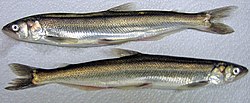Eulachon
| Eulachon | |
|---|---|

| |
| Scientific classification | |
| Kingdom: | |
| Phylum: | |
| Class: | |
| Order: | |
| Family: | |
| Genus: | Thaleichthys Girard, 1858
|
| Species: | T. pacificus
|
| Binomial name | |
| Thaleichthys pacificus (J. Richardson, 1836)
| |
The eulachon (Thaleichthys pacificus), also oolichan, hooligan, ooligan, or candlefish, is a small anadromous ocean fish, a smelt found along the Pacific coast of North America from northern California to Alaska.
Etymology
The common names of this fish have a somewhat confusing relationship. The name "candlefish" derives from it being so fat during spawning, with up to 15% of total body weight in fat, that if caught, dried, and strung on a wick, it can be burned as a candle. This is the name most often used by early explorers. The name eulachon (occasionally seen as oolichan, oulachon, and uthlecan) is from the Chinookan language and the Chinook jargon based on that language. The name "hooligan" appears to have been derived from "eulachon" by similarity with the English slang term for a ruffian or scoundrel which gained currency in the late 19th century. [citation needed]
The unrelated sablefish Anoplopoma fimbria is also called "candlefish" in the United Kingdom.
Species description
Eulachon are distinguished by the large canine teeth on the vomer bone and 18 to 23 rays in the anal fin. Like salmon and trout they have an adipose fin; it is sickle-shaped. The paired fins are longer in males than in females. All fins have well-developed breeding tubercles (raised tissue "bumps") in ripe males, but these are poorly developed or absent in females. Adult coloration is brown to blue on the back and top of the head, lighter to silvery white on the sides, and white on the ventral surface; speckling is fine, sparse, and restricted to the back.[1] Adults can reach maximum lengths of 30 cm (1 ft) but most adults are between 15 to 20 cm (6 to 8 in.)[2] They feed on plankton but only while at sea.[1]
Ecology
Eulachon feed primarily on plankton as well as fish eggs, insect larvae, and small crustaceans. It forms an important part of the diet of many ocean and shore predators, and serves as a prominent food source for people living near its spawning streams.
Eulachon, as anadromous fish, spend most of their adult lives in the ocean but return to their natal freshwater streams and rivers to spawn and die. As such, one stream may see regular large runs of eulachon while a neighboring stream sees few or none at all. Regular annual runs are common but not entirely predictable, and occasionally a river which has large runs sees a year with no returns; the reasons for such variability are not known. The eulachon run is characteristic for the early portion being almost entirely male, with females following about midway through the run to its conclusion.[citation needed] Males are easily distinguished from females during spawning by fleshy ridges which form along the length of their bodies.[clarification needed]
Economics and trade
Indigenous communities of the Pacific Coast from California to Alaska made eulachon an important part of their diet, as well as a valuable trade item with peoples whose territories did not include spawning rivers. The species was caught using traps, rakes, and nets. The harvest continues today, with other residents taking part in the exploitation of the large runs. Today harvested eulachon are typically stored frozen and thawed as needed. They may also be dried, smoked, or canned. Eulachon were also processed for their rich oil. The usual process was to allow the fish to decompose for a week or more in a pit in the ground, then add boiling water and skim off the oil, which would rise to the surface. Eulachon oil (also known as "grease") was the most important product traded into the interior; as a result, the trails over which the trade was conducted came to be known as grease trails. Other uses of eulachon by non-Natives include bait for sportfishing and food for cats and dogs.
Conservation status
On November 2008, the National Marine Fisheries Service (NMFS) received a petition from the Cowlitz Tribe to list a distinct population segment (DPS) of eulachon from Washington, Oregon, and California, (the so-called Southern DPS) as an endangered or threatened species under the Endangered Species Act.[3] (ESA). NMFS found that this petition presented enough information to warrant conducting a status review of the species. Based on the status review NMFS proposed listing this species as threatened on March 13, 2009.[4] On March 16, 2010, NOAA announced that the Southern DPS of eulachon will be listed as threatened under the ESA, effective on May 17, 2010 (See: the Federal Register notice published on May 18, 2010, at 74 FR 3178).[5]
References
- ^ a b "Pacific Eulachon/Smelt (Thaleichthys pacificus)". NOAA Fisheries Office of Protected Resources. National Marine Fisheries Service. August 6, 2013. Retrieved 31 January 2014.
- ^ McGinnis, Samuel M. (2006). Field guide to freshwater fishes of California (Revised ed.). Berkeley: University of California Press. pp. 202–203. ISBN 0520237277.
- ^ "Endangered Species Act".
- ^ "Proposed listing status for Pacific eulachon" (PDF).
- ^ "NOAA's Eulachon listing status history".
- "Thaleichthys pacificus". Integrated Taxonomic Information System. Retrieved 11 March 2006.
- The First Sign of Spring: OOLIGAN
- National Marine Fisheries Service eulachon webpage
External links
- FishBase entry for Thaleichthys pacificus
- Preserving the Tradition of T'lina Making - Virtual Museum Exhibit of Kwakwaka'wakw eulachon oil production
- Making Oolichan grease in Kemano, online exhibit on Haisla eulachon grease making
